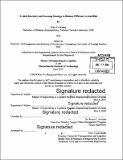A joint inventory and sourcing strategy to balance efficiency versus risk
Author(s)
Huang, Wan-Yu, M.Eng. Massachusetts Institute of Technology; Liu, Jierui
DownloadFull printable version (17.42Mb)
Other Contributors
Massachusetts Institute of Technology. Engineering Systems Division.
Advisor
Bruce C. Arntzen.
Terms of use
Metadata
Show full item recordAbstract
This research sought to identify the right strategy to mitigate the supply chain risk while maintaining supply chain efficiency for a company in the medical device industry. The company in our case was exposed to great risk of supplier disruption because of its single source practice. In general, there are two different approaches to reduce the impact of supplier disruption. One is holding additional inventory to cover the demand over the time-to-recovery, and the other is maintaining a second source to reduce the risk. In this research, we proposed a method of distinguishing the better approach. First, we classified the SKUs by criticality and complexity, evaluated the current inventory policy and inventory status, defined the time-to-recovery for each SKU, estimated the potential revenue lost over the time-to-recovery, calculated the additional inventory required, and calculated the related cost for both holding additional inventory and maintaining a second source. Then, we compared the three ROA ratios from holding additional inventory, maintaining a second source, and not taking any action (potential sales lost). The strategy with the highest ROA ratios represented the most efficient way to prevent the risk of supplier disruption. Based on the analysis, holding additional inventory was generally a better strategy for the company in the medical device industry to protect itself from the risk of supplier disruption in any given level of supplier risk.
Description
Thesis: M. Eng. in Logistics, Massachusetts Institute of Technology, Engineering Systems Division, 2014. Cataloged from PDF version of thesis. Includes bibliographical references (pages 70-72).
Date issued
2014Department
Massachusetts Institute of Technology. Engineering Systems DivisionPublisher
Massachusetts Institute of Technology
Keywords
Engineering Systems Division.